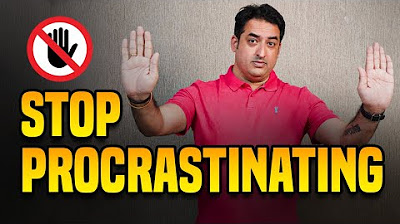How To Prioritize What To Do In A Day (6 Steps)
Summary
TLDRThe video focuses on effective task prioritization to increase productivity by focusing on key issues rather than an overwhelming list of tasks. The speaker outlines six steps for organizing and prioritizing tasks: listing all tasks, identifying the problems they solve, eliminating tasks that don't solve important problems, pinpointing the biggest issue, and ranking tasks based on input vs. output. The goal is to focus on high-impact tasks that require minimal effort but yield maximum results. This method helps reduce stress, allowing individuals to work smarter, not harder.
Takeaways
- 📝 Write down all your tasks, ideas, and problems on a separate board or list first, rather than immediately adding them to your calendar.
- ❓ Identify the problem each task solves. If a task doesn't solve a specific problem, it should be removed.
- 🔍 Separate business and personal tasks, as they solve different kinds of problems.
- 🎯 Determine the biggest overarching problem in your business or life by using logic to identify bottlenecks.
- 🔗 Prioritize tasks that solve the biggest problem you identified. Group tasks that focus on this problem together.
- 📊 Rank tasks based on two factors: the input required and the output gained, focusing on high-output, low-input tasks.
- ⏳ Take action on the top one or two tasks that offer the best return on time and effort.
- 🚫 Avoid doing tasks immediately without evaluation. Consider how much value they add before jumping in.
- 💡 Constantly add new ideas to an idea list but avoid acting on them right away. Reassess their priority later.
- 🏆 Think like a CEO—evaluate tasks based on how much they help achieve growth or success. Only act on tasks that align with your core goals.
Q & A
What is the first step to prioritizing tasks according to the script?
-The first step is to write down a list of all the tasks and ideas you have, without putting them in your calendar or to-do list yet. These can be personal or business-related tasks.
How do you determine whether a task should be kept on your list?
-You should write down what problem each task solves. If you can't clearly articulate what problem a task solves, it should be removed, as it may not be necessary.
Why is it important to separate business and personal tasks in the prioritization process?
-It's recommended to separate them because the problems you're solving in business are different from the problems in personal life. This helps in clearer and more effective prioritization.
How do you identify the biggest problem in your business or life?
-To identify the biggest problem, use logic. Ask yourself which issue, if solved, would make the other problems easier or eliminate them. This is the bottleneck you should focus on.
Once you have identified the biggest problem, what should you do next?
-You should look at your task list and identify which tasks solve the biggest problem. Group those tasks separately to focus on them first.
How should you rank tasks once you have identified those that solve the biggest problem?
-Rank tasks based on two factors: the input required (time, money, effort) and the output gained. Ideally, prioritize tasks that require low input but offer high output.
Why is it important to consider both the input and output when ranking tasks?
-Considering both helps ensure that you are working on tasks that provide the greatest return on investment in terms of time and effort, maximizing productivity.
What mindset should you adopt when deciding whether to take action on a new task or project?
-Adopt a CEO mindset, like Jeff Bezos or Warren Buffett. Before taking on a new task, ask whether it helps grow the business or achieve your main goals. If it doesn't, deprioritize it.
How should you handle new ideas that come up while you are focusing on existing tasks?
-Add new ideas to an 'idea list' but do not take action on them immediately. Evaluate and prioritize them later based on their relevance to your biggest problem.
What is the overall goal of the prioritization process described in the script?
-The goal is to simplify your workload by narrowing down your tasks to those that directly address the biggest problems. This allows you to work more efficiently, achieve higher impact with less effort, and avoid feeling overwhelmed.
Outlines

Esta sección está disponible solo para usuarios con suscripción. Por favor, mejora tu plan para acceder a esta parte.
Mejorar ahoraMindmap

Esta sección está disponible solo para usuarios con suscripción. Por favor, mejora tu plan para acceder a esta parte.
Mejorar ahoraKeywords

Esta sección está disponible solo para usuarios con suscripción. Por favor, mejora tu plan para acceder a esta parte.
Mejorar ahoraHighlights

Esta sección está disponible solo para usuarios con suscripción. Por favor, mejora tu plan para acceder a esta parte.
Mejorar ahoraTranscripts

Esta sección está disponible solo para usuarios con suscripción. Por favor, mejora tu plan para acceder a esta parte.
Mejorar ahoraVer Más Videos Relacionados

Increase productivity by 300% with this small change!

The CIA method for making quick decisions under stress | Andrew Bustamante

CIA Spy: If You're Ambitious But Overwhelmed, Watch This...

7 Cara Efektif Berhenti Nunda" dan Males (Tips Stop Prokrastinasi)

Working from Home: How to Plan Your Day

Stop Procrastinating | 13 Best Time Management Techniques | Increase Productivity #productivityhacks
5.0 / 5 (0 votes)
